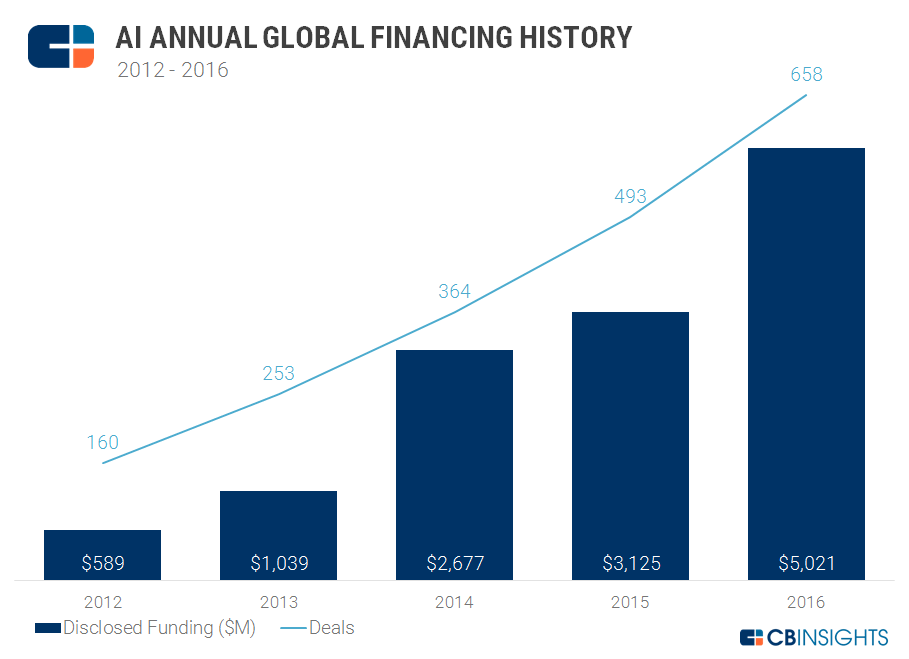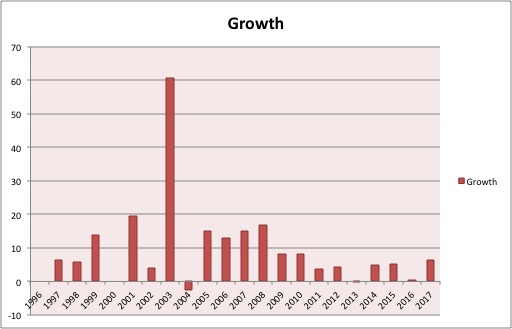Provisional data suggests:
- Equity deals made with startups in AI were worth about $5bn in 2016, and this value has been growing by around 50% per year in recent years.
- The number of equity deals in AI startups globally is growing at around 30% per year, and was estimated at 658 in 2016.
- NSF funding of IIS, a section of computer science that appears to include AI and two other areas, has increased at around 9% per year over the past two decades.
(Updated February 2017)
Background
Artificial Intelligence research is funded both publicly and privately. This page currently contains some data on private funding globally, public funding in the US, and national government announcements of plans relating to AI funding. This page should not currently be regarded as an exhaustive summary of data available on these topics or on AI funding broadly.
Details
AI startups
According to CB Insights, between the start of 2012 and the end of 2016, the number of equity deals being made with startups in artificial intelligence globally grew by a factor of four to 658 (around 30% per year), and the value of funding grew by a factor of over eight to $5 billion (around 50% per year).1 Their measure includes both startups developing AI techniques, and those applying existing AI techniques to problems in areas such as healthcare or advertising. They provide Figure 1 below, with further details of the intervening years. We have not checked the trustworthiness or completeness of CB Insights’ data.

US National Science Foundation
In 2014, Muehlhauser and Sinick wrote:
In 2011, the National Science Foundation (NSF) received $636 million for funding CS research (through CISE). Of this, $169 million went to Information and Intelligent Systems (IIS). IIS has three programs: Cyber-Human Systems (CHS), Information Integration and Informatics (III) and Robust Intelligence (RI). If roughly 1/3 of the funding went to each of these, then $56 million went to Robust Intelligence, so 9% of the total CS funding. (Some CISE funding may have gone to AI work outside of IIS — that is, via ACI, CCF, or CNS — but at a glance, non-IIS AI funding through CISE looks negligible.)
…
The NSF Budget for Information and Intelligent Systems (IIS) has generally increased between 4% and 20% per year since 1996, with a one-time percentage boost of 60% in 2003, for a total increase of 530% over the 15 year period between 1996 and 2011.[14 {See table with upper left-hand corner A367 in the spreadsheet.}] “Robust Intelligence” is one of three program areas covered by this budget.
As of February 2017, CISE (Computer and Information Science and Engineering) covers five categories, and IIS appears to be the most relevant one.2 IIS still has three programs, of which Robust Intelligence is one.3
NSF funding into both CISE and IIS (the relevant subcategory) from 2009 to 2017 shows a steady rise.4 IIS funding as a percentage of CISE funding fluctuates, and has gone down in this time period. The following table summarizes data from NSF, collected by Finan Adamson in 2016. The figures below it (2 and 3) combine this data with some collected previously in this spreadsheet linked by Muehlhauser and Sinick. Over 21 years, IIS funding has increased fairly evenly, at 9% per year overall.
| Fiscal Year | IIS (Information and Intelligent Systems) Funding
In Millions of $ |
Total CISE (Computer and Information Science and Engineering Funding in Millions of $ | IIS Funding as a % of total CISE Funding |
| 2017 (Requested) | 207.20 | 994.80 | 20.8 |
| 2016 (Estimate) | 194.90 | 935.82 | 20.8 |
| 2015 (Actual) | 194.58 | 932.98 | 20.9 |
| 2014 (Actual) | 184.87 | 892.60 | 20.7 |
| 2013 (Actual) | 176.23 | 858.13 | 20.5 |
| 2012 (Actual) | 176.58 | 937.16 | 18.8 |
| 2011 (Actual) | 169.14 | 636.06 | 26.5 |
| 2010 (Actual) | 163.21 | 618.71 | 26.4 |
| 2009 (Actual) | 150.93 | 574.50 | 26.3 |


National governments
US
On May, 3 2016 white house Deputy U.S. Chief Technology Officer Ed Felten announced a series of workshops and an interagency group to learn more about the benefits and risks of artificial intelligence.5
The Pentagon intended to include a request for $12-15 Billion to fund AI weapon technology in its 2017 fiscal year budget.6
Japan
Ms. Kurata from the Embassy of Japan introduced Japan’s fifth Science and Technology Basic Plan, a ¥26 trillion government investment that will run between 2016-2020 and aims to promote R&D to establish a super smart society.7
China
The Chinese government announced in 2016 that it plans to create a “100 billion level” ($15 billion USD) artificial intelligence market by 2018. In their statement, the Chinese government defined artificial intelligence as a “branch of computer science where machines have human-like intelligence” and includes robots, natural language processing, and image recognition.8
South Korea
The South Korean government announced on March 17, 2016 that it would spend 1 trillion won (US$840 million) by 2020 on Artificial Intelligence. They plan to fund a high profile research center joined by Samsung and LG Electronics, SKT, KT, Naver and Hyundai Motor.9
Relevance
Financial investment in AI research is interesting because as an input to AI progress, it may help in forecasting progress. To further that goal, we are also interested in examining the relationship of funding to progress.
Investment can also be read as an indicator of investors’ judgments of the promise of AI.
Notable missing data
- Private funding of AI other than equity deals.
- Public funding of AI research in relevant nations other than the US.
- Funding for internationally collaborative AI projects.
- “Our analysis includes companies applying AI algorithms to verticals like healthcare, security, advertising, and finance as well as those developing general-purpose AI tech. Our list excludes robotics (hardware-focused) and AR/VR startups, which we’ve analyzed separately here and here. Our analysis includes all equity funding rounds and convertible notes. This post was updated on 1/19/2017 to include deals through the end of 2016….Deals reached a 5-year high last year, from 160 deals in 2012 to 658 in 2016. Dollars invested also rose considerably in 2016, up about 60%.” – CB Insights, https://www.cbinsights.com/blog/artificial-intelligence-startup-funding/ (See also Figure 1)
- “…IIS also invests in research on artificial intelligence, computer vision, natural language processing, robotics, machine learning, computational neuroscience, cognitive science, and areas leading to the computational understanding and modeling of intelligence in complex, realistic contexts.” – CISE Funding, Directorate for Computer and Information Science and Engineering (CISE).
- CISE’s Division of Information and Intelligent Systems (IIS) supports research and education projects that develop new knowledge in three core programs:
- The Cyber-Human Systems (CHS) program;
- The Information Integration and Informatics (III) program; and
- The Robust Intelligence (RI) program.
- NSF Budget:
http://www.nsf.gov/about/budget/fy2017/pdf/18_fy2017.pdf
https://www.nsf.gov/about/budget/fy2016/pdf/18_fy2016.pdf
http://www.nsf.gov/about/budget/fy2015/pdf/18_fy2015.pdf
https://www.nsf.gov/about/budget/fy2014/pdf/18_fy2014.pdf
http://www.nsf.gov/about/budget/fy2013/pdf/06-CISE_fy2013.pdf
https://www.nsf.gov/about/budget/fy2012/pdf/17_fy2012.pdf
https://www.nsf.gov/about/budget/fy2011/pdf/06-CISE_fy2011.pdf
- White House Office of Science and Technology Policy, https://www.whitehouse.gov/blog/2016/05/03/preparing-future-artificial-intelligence
- Business Insider, http://www.businessinsider.com/the-pentagon-wants-at-least-12-billion-to-fund-ai-weapon-technology-in-2017-2015-12
- UK-RAS Network, http://hamlyn.doc.ic.ac.uk/uk-ras/news/japan-uk-collaboration
- Technode, http://technode.com/2016/05/27/chinese-goverment-wants-100-billion-level-artificial-intelligence-market-2018/
- Yonhap News Agency, http://english.yonhapnews.co.kr/news/2016/03/17/0200000000AEN20160317003751320.html



Thanks for writing this.
Are there any studies on the effectiveness of government funding on the AI industries, say in terms of AI startup-formation or AI company performance?